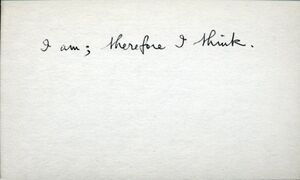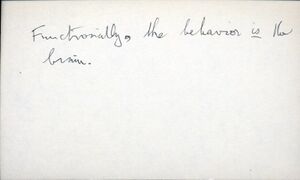Steps Towards a (Media) Ecology
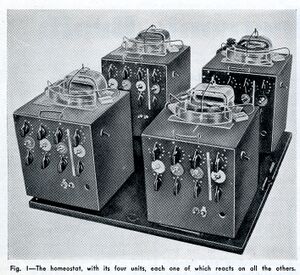
"We take as basic the assumptions that the organism is mechanistic in nature, that it is composed of parts, that the behaviour of the whole is the outcome of the compounded actions of the parts, that organisms change their behaviour by learning, and that they change it so that the later behaviour is better adapted to their environment than the earlier. Our problem is, first, to identify the nature of the change which shows as learning, and secondly, to find why such changes should tend to cause better adaptation for the whole organism." [1]
“When a kitten first approaches a fire its reactions are unpredictable and usually inappropriate. It may walk almost into the fire, or it may spit at it, or may dab at it with a paw, or try to spit at it, or crouch and 'stalk' it. Later, however, when adult, its reactions are different. It approaches the fire and seats itself at a place where the heat is moderate. If the fire burns low, it moves nearer. If a hot coal falls out, it jumps away. Its behaviour towards the fire is now 'adaptive'. I might have taken as type-problem some experiment published by a psychological laboratory, but the present example has several advantages. It is well known; it is representative of a wide class of important phenomena; and it is not likely to be called in question by the discovery of some small technical flaw.”[2]
W. Ross Ashby – Design for a Brain
ROSS ASHBY ON THE HOMEOSTAT
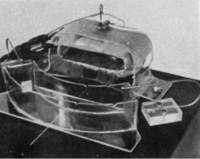
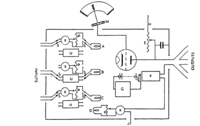

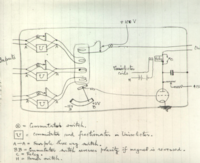
The Homeostat is a four unit machine built by Ross Ashby from parts of old WWII planes and spare components. The machine maintains equilibrium despite perturbation to the system. This cybernetic organism, by feeding back information from its environment and adapting to any changes made, maintains a ultrastable state (“homeostasis”). The homeostat models a number of ultrastable systems: including an organism, an environment and a brain.
The most remarkable thing about the homeostat is that – because it is designed to correct any input which might threaten its stability – it works best when it does very little. When it was built, it was difficult for the cyberneticians at the 1952 Macy conference on cybernetics to make an assessment of the homeostat. Could the actions it performed be classed as behaviour? Does that behaviour constitute thinking?
From Ashby's perspective, biological organisms (and feedback machines such as the homeostat), are able to alter their patterns of response and bring critical variables back into the desired range. In these cases, energy takes little part in allowing the adaptation of the organism-servo-machine to its environment. Adaptation is afforded through the amount of information running through the system, which allows the organism (or servo machine) to maintain order at the boundary between two loosely coupled systems. In this way learning increases variety (this principle is expressed mathematically in Ashby's Law of Requisite Variety).[3]
Those attending Ashby's presentation of this “organism box” at the 1952 Macy conference [4], were puzzled by the claim that Ashby made for a broad field of evolutionary development. This led Julian Bigalow to remark: “It may be a beautiful replica of something, but heaven only knows what.”[5] Norbert Wiener, by contrast recognised the value of a machine which could model any self-organising system, and which allowed for an equivalence between adaptation and learning, Wiener described the homeostat as a “purposeful random mechanism which seeks for its own purpose through the process of learning”.
Whilst some saw the generality of the machine as a shortcoming (it was too general to tell us anything of specific use), others (notably Gregory Bateson) understood it as a breakthrough in understanding a structural equivalence on a number of levels – from the machine, to the individual organism, to the environment. In its ability to model a general system, the homeostat expressed the form of performative model Kenneth Craik had written about in The Nature of Explanation, the homeostat modelled the structure of the behaviour of a system without looking anything like the machine, organism, or environment it modelled.
In what follows we will see how – just as the cybernetic tortoise invites discussions into the nature of self, the intersubjective, and the nature of consciousness – the homeostat will invite questions about the dividing line between organism and environment, ecology and media, behaviour and thought.
The homeostat, in its generality, stands at the intersection between a ‘positivist’ cybernetics – whereby the observer can make observations about the actions of a particular thing without affecting the thing being observed – into a self-reflexive cybernetics, in which information from the environment feeds back to allow the observer to act on the information received (this will come to be known as 'second-order cybernetics'). This new emphasis (whereby “noise” can be reflexively modelled into “information”) will be at the foundation of an aesthetic revolution in the late 1950s and 1960s (as we will see in subsequent chapters) and, in a related development, will draw the human subject into the ecological feedback loop.
Th homeostat provided a model for Gregory Bateson to extend his ecology of mind still further, as Ashby’s notions of “requisite variation:” and “flexibility” are applied by Bateson to the realms of biology, ecology, and social cohesion.[6] Ashby's influence will be particularly apparent in texts which deal with the ecological crisis, such as Bateson's Restructuring the Ecology of a Great City. We will look at this text in more detail in the following chapter, where I examine how the discourses of ecology, media and the counterculture entangle. Below I will discuss Conscious Purpose Versus Nature, in which Bateson refines his cybernetic epistemology to encompass conscious choice and its relation to a broader ecology.
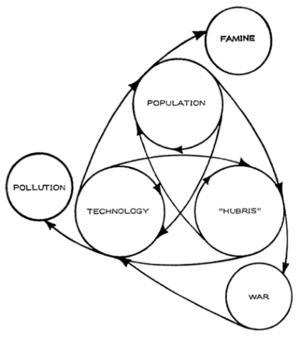
CONSCIOUS PURPOSE–ECOLOGY
There is an ecology of bad ideas, just as there is an ecology of weeds.
– Gregory Bateson, Steps to an Ecology of Mind
Gregory Bateson's Conscious Purpose Versus Nature was delivered at the Dialectics of Liberation conference in 1968.[7] The event was convened by the British psychiatrist R. D. Laing (whose own “anti-psychiatry” was influenced by Bateson's double bind communication). The event subsequently became something of a landmark in the history of the 1960s counterculture.[8] Bateson's text is noteworthy because it brings together elements that are familiar to us, presenting a survey of Bateson's career as a cybernetic epistemologist. The text, which is laced with parables, takes us to the beginnings of our fabulous loop de loop, from a consideration of the place of Lamarkian evolutionary theory, through to discussion of the construction of the subject within a matrix of communication and on into a broader ecological realm (Bateson was at the time engaged in research into dolphin communication).
In the text, Bateson notes that the chain of being and the place of the mind within it – as it had been understood in pre-modern and in non-occidental cultures – has suffered a reversal in the modern Western scientific era. In the modern conception the supreme mind (God/ mind of Man) was at the top, enjoying mastery over the creatures below him, from the higher primates to the protozoa bubbling at the bottom. Bateson argues that this conception does not allow for a conception of mind as imminent within a series of co-extensive systems. The publication of Jean-Baptiste Lamarck's evolutionary theory in Philisophie Zoologique (1809), at the beginning of the 19th century – “the first organised transforms theory of evolution”.[9] ushered in a Copernican revolution in the biological field. Philosophie Zoologique is revolutionary, Bateson contends, because it acknowledged that the order of nature runs in a converse direction, suggesting that mind is indeed emergent and imminent within an ecology. Up until Lamarck “mind was an explanation of the biological world. But, Hey presto, the question now arose: is the biological world the explanation of mind?” […] “Some years [after Lamarck], Alfred Russel Wallis, in his correspondence to Charles Darwin described the process of natural selection as akin to the regulation of a steam engine by a governor.”)[10] The full implications of Wallis' insight, that such ecological systems are regulated by negative feedback (an observation also made by Samuel Butler, you may remember), lay dormant until after WWII when the revolution in cybernetics and communication theory allowed for a clearer understanding of feedback as a general regulating principle within different scaled ecological systems (from a single cell to a complex environment, such as Spaceship Earth). It also allowed for an understanding of the formation of social relations and individuation of the human psyche as a process of circular causality driven by purpose. If pre-modern societies had an understanding that mind was coextensive within a series of systems, this was rediscovered in the post-cybernetic era as “nowadays cybernetics deals with much more complex systems”. Human behaviour, human organisation, any biological systems which are all self-corrective. Such systems are always conservative of something, the change in the fuel supply effects the motion of the flywheel which is regulated by the governor. [11] This transaction, in relation to any system, might be understood as survival.
THE SCREEN OF CONSCIOUSNESS
Bateson next directs this tendency of self-correcting systems toward conservatism to the subject of the human psyche. Bateson notes that the difficulty people have in seeing the obvious, or with coping with disturbing information is an artefact of the system. The tendency to reinforce resistance to the obvious or the disturbing is systematic. “This is a system which conserves descriptive statements about the human being, body and soul. For the same is true of the psychology of the individual, where learning occurs, to conserve the opinions and components of the status quo.” Society and the ecosystem are systems of the same general kind. In all such systems there is an “uneasy balance of dependency and competition”. The components of a system are “segmented” so that change is localised [...] The biological system is driven to reproduce, even if, to state the obvious, overpopulation will result in a strain on the larger system: any “monkeying with the system is likely to disrupt the equilibrium.”[12]. It is therefore, “quite a trick” to balance dependency and competition. The system is segmented so that no single part has access to the “total mind”. However, and here Bateson introduces a mysterious (almost mystical element), “there is a 'semipermiable' linkage between consciousness and the remainder of the total mind. A certain limited amount of information about what is happening in this larger part of the mind seems to be relayed to what we may call the screen of consciousness.”[13] Because the screen of consciousness is a filtration system it necessarily provides partial information. The whole mind cannot be comprehended in part of that mind, to comprehend the circuitry of the system would require more circuitry which produces an infinitely recursive logic &c. The question now arises, how is this limited selection of information which plays on the screen of consciousness selected and filtered? “I am guided in my perception by purposes.”, thought is responsive and immanent “I get a myth about this subject which might be quite correct. I am interested in getting that myth as I talk. It is relevant to my purposes that you hear me.”[14]. In this anecdote thought is imminent to purpose. Purpose becomes that which builds subjects and relations between subjects within the system. Here subjects and objects are performativly produced within a circuit of communication where competition and dependency are central agents.
Here Bateson mounts a critique of instrumental reason and the instrumentalisation of cybernetic principles: “What happens to the picture of a cybernetic system [...] when that picture is selectively drawn to answer only questions of purpose?”[15]If a system is organized only in terms of purpose it ends up with a “bag of tricks” and no wisdom about the system as a whole, it is organised to arrive at short cuts and quick fixes and to follow the shortest logical path, which may be “dinner; it may be a Beethoven sonata; it may be sex. Above all it may be money and power.”[16]. The cause for concern, for Bateson, is the “addition of modern technology to the old system”. The system orientated by purpose that consciousness has been using for more than a million years has produced more effective machinery “transportation systems, airplanes, weaponry, medicine, pesticides, and so forth” through the agency of conscious purpose.[17]
“After they had cast God out of the Garden, they really went to work on this purposive business, and pretty soon the topsoil disappeared. After that, several species of plants became “weeds” and some of the animals became “pests”; and Adam found that gardening was much harder work. He had to get his bread by the sweat of his brow and he said, “It's a vengeful God. I should never have eaten that apple.””[18]
Bateson gives an account of conscious purpose which begins in myth. God, in a retelling of the Judo-Christian creation myth, was cast out of the garden on the day that Adam and Eve worked out how to stack one box on top of another in order to get their hands on the apple. At the point at which they realised that A & B can result in C, and were defined by a local aim and purpose, whilst being rulers of their own garden, they were “cast out of the garden of the concept of their own systemic nature.” Our consciousness is conditioned to conscious purpose, which is projected onto the screen of our consciousness, such purpose defines the subjects and objects in our world, we produce technologies to meet those purposes, together these things constitute a system which we strive to preserve. We see as through a glass darkly – “Consciousness is blinded to the systematic nature of the individual man”.
Bateson continues to wax biblical: “Lack of systematic wisdom is always punished”.[19] when presenting the cybernetic paradox of consciousness. Bateson continues to call for a revision of “the occidental errors of epistemology”[20], and calls for a humility in the face of nature and in relation to what is known by human beings. Bateson finds useful models in Zen Buddhism, which challenges the sovereignty of the self in relation to natural systems; artistic or aesthetic pursuits which operate under the order of self-reflexive deutero-learning, which alters the register of hierarchical perception; the 'best of religion' serves as a corrective to 'overrun' (positive feedback producing inflexibility and instability within a system).
In this respect the lines of engagement are ostensibly the same as the 1950s, but the stakes at the end of the 1960s, when an ecological disaster seems imminent, are more desperate. Bateson wrote in Radical Software: “... all of the many current threats to man's survival are traceable to three root causes: a) technological progress b) population increase c) certain errors in the thinking and attitudes of occidental culture. (Our “values” are wrong!)”[21]
BATESON – MEDIA ECOLOGY

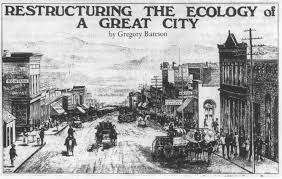
If the cybernetic tortoise provided the model for the construction of the self within the environment, Ashby's homeostat provided the model for the organisation of organic and ecological systems. This is apparent in two texts Gregory Bateson published in the video journal Radical Software at the beginning of the 1970s: Restructuring the Ecology of a Great City (which I will discuss in greater detail in the next chapter) and the ecological polemic Awake![22]
In Ashby's model, and Bateson's city, flexibility operates within set parameters, the upper and lower limits of which are strained when tested. The ideal environment, for Bateson, would be one which affords the maximum flexibility, which in turn affords adaptation. Less flexibility will result in less sustainability as the system is tested beyond its limits. Humans routinely find themselves in an ecological pickle when a sub-system seeks to preserve aspects within itself which run contrary to the order of the greater system. In such circumstances, the task for humans is to operate on a deutero level and control ecological resources, correcting the human pathologies which routinely inflict modern modes of organisation. [23]
It is at this point where conscious purpose loops into a broader ecological system.
Gregory Bateson's text Awake (1971) appeared in the fifth issue of Radical Software. It clearly annotates the errors in epistemology that threaten the future of spaceship earth in the second half of the twentieth century.
“[T]he ideas which dominate our civilization at the present time date in their most virulent form [are] from the Industrial Revolution.
a) It's us against the environment.
b) It's us against other men.
c) It's the individual (or the individual company, or the individual nation) that matters.
d) We can have unilateral control over the environment and must strive for that control.
e) We live within an infinitely expanding “frontier.”
f) Economic determinism is common sense.
g) Technology will do it for us.
We submit that these ideas are simply proved false by the great but ultimately destructive achievement of our technology in the last 150 years. Likewise they appear to be false under modern ecological theory. The creature that wins against its environment destroys itself...”[24]
In 1971 there was nothing unusual about an ecological polemic appearing in a magazine devoted to the uses and maintenance of portable video systems (the Portapak, the next machine on our loop de loop). There was already an abiding connection between the notion of an ecological system regulated by feedback and a technological system regulated by the same principle. And the parallel notions of “ecology” were not simply analogous, they are systematically and structurally bound together. Steps in a broader ecology of mind which bound the Protozoa to the media system.
The attraction of the Portapak was that it produced a circuitry of relations, and provided a new context in which the individual and their relation to the collective could be examined, re-examined, and performed. The revolution proposed in the pages of Radical Software described a shift from a spectacular form of media to a performative form, in which the self and the community would evolve together in a networked media ecology.
In the next chapter I will investigate the multifarious strands that brought this media culture into existence. I will discuss the antecedent of Radical Software, the counterculture magazine The Whole Earth Catalog. This publication appeared within a context in which cybernetic ideas had begun to permeate into the broader culture and, increasingly, define a counterculture. I will investigate how in the 1950s and 1960s aesthetics and ecology are increasingly read through a cybernetic lens, and discover Gregory Bateson's notion of an ecology of mind at the centre.
- ↑ Ross Ashby, Design for a Brain, John Wiley and Sons Publishing, 1952p. 12
- ↑ W. Ross Ashby, Design for a Brain, John Wiley and Sons Publishing, 1952 p.12
- ↑ Peter Harries-Jones, A Recursive Vision: Ecological Understanding and Gregory Bateson p.109
- ↑ “organism box” was coined by Gerard at the 1952 Macy conference. Others in the discussion included McCulloch, Pitts, Bateson, Bigalow and Wiener Cybernetics, The Macy Conferences p 86
- ↑ Pias, Claus, ed. Cybernetics | Kybernetik: The Macy-Conferences 1946-1953, Volume 1 Transactions. Edited by Claus Pias: Diaphanes 2004, p.96
- ↑ Bateson, Restructuring the Ecology of a Great City, Radical Software no 4 1970; & Bateson, Conscious Purpose Versus Nature. Steps to an Ecology of Mind 433
- ↑ Bateson Steps to an Ecology of Mind 433-446, 1967
- ↑ For better and for worse. The event was criticised for its sexism – no female speakers were invited and those that did try to speak were patronised or overlooked – and served, unintentionally, as a recruiting event for the feminist cause. For more details on the event see http://www.dialecticsofliberation.com/1967-dialectics
- ↑ Bateson, Steps to an Ecology of Mind 455
- ↑ Steps to an Ecology of Mind 435 Bateson also gives an account of this in Stewart Brand's For God Sake Margaret!, Co-Evolutionary Quarterly 197*
- ↑ Steps to an Ecology of Mind 435
- ↑ Bateson, Steps to an Ecology of Mind 437
- ↑ Bateson Steps to an Ecology of Mind , 438
- ↑ Bateson Steps to an Ecology of Mind , 438
- ↑ Bateson Steps to an Ecology of Mind ,439
- ↑ Bateson Steps to an Ecology of Mind ,440
- ↑ Bateson Steps to an Ecology of Mind ,441
- ↑ Bateson, Steps to an Ecology of Mind 423
- ↑ Bateson Steps to an Ecology of Mind 441
- ↑ Bateson Steps to an Ecology of Mind 495
- ↑ Gregory Bateson, Awake, Radical Software No 5 Volume 1, p.33
- ↑ Gregory Bateson, Awake, Radical Software No 5 Volume 1, p.33; Gregory Bateson Restructuring the Ecology of a Great City, Radical Software no 4 1971
- ↑ Gregory Bateson Restructuring the Ecology of a Great City, Radical Software no 4 1971
- ↑ Gregory Bateson Radical Software Issue 5 Volume 1, Bateson Steps to an Ecology of Mind . 87
